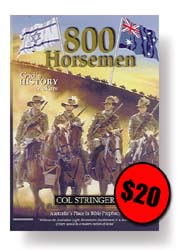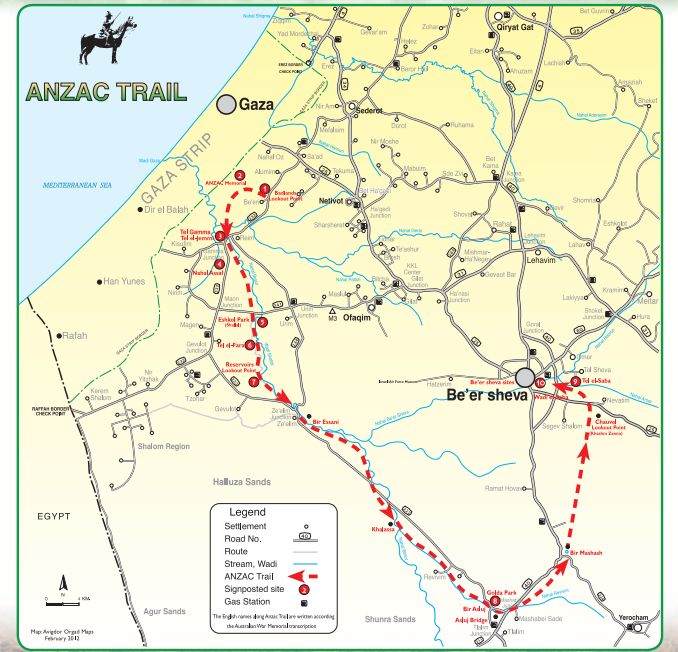 Jerusalem's Aussie
Deliverers 1917
Jerusalem's Aussie
Deliverers 1917
 Jerusalem's Aussie
Deliverers 1917
Jerusalem's Aussie
Deliverers 1917
Beersheba - Well Of The Oath. The key to the battle were the Gaza Beersheba fortifications. Beersheba, meaning "well of the oath" read more, had been so named by Abraham in the book of Genesis. Water was the life blood of the desert and Beersheba was where the Turks had sole possession of 17 wells. On October 31 1917, 50,000 British, Aussie and New Zealand troops, supported by tank and artillery, attacked the Turkish defences at Beersheba. With difficulty and losses they secured their objectives south and east of the town, overcoming barbed wire defences by early afternoon and two hilltops by late afternoon, along with instructions to leave the taking of the town to mounted troops.
But with sunset fast approaching, the situation was grim. Many horses had been ridden across the searing desert in 50 degree heat without water for 48, and in some cases 70 hours. The men only had the little water they carried in their small canteens. Failure appeared imminent, with the likelihood the desert would soon defeat men & horses. The fact they would have to retire to water 48kms south-west in Bir Essani would have left the infantry divisions in action right to Gaza "in a terrible fix" — Ion Idriess
It was then that Brigadier Grant of the Australian 4th Light Horse Brigade
Just after 4.30pm in the desert heat of that late autumn, the men set off. Riding west, directly into the sun, first in a canter, but soon breaking into a strong gallop. Kicking up thunderous clouds of dust in three waves the 4th Regiment took the right flank and the 12th the left. Through exploding shells the Light Horsemen, 5 metres apart, galloped with determination and valour. Closer and closer they came till the Turks couldn't lower their artillery guns any further. These brave men continued on, riding under the Turkish guns, making them ineffective.
As they approached the Turkish trenches, the machine guns now came against them. The Turkish troops in their trenches had set their sights at 1600 metres. As the Light Horse charged closer, in desperation, or confusion caused by the clouds of dust, or for whatever reason, the majority of the Turks did not adjust their sights, shooting over the heads of the advancing horsemen. As they leapt the trenches laced with machine gun bullets, a magnificent cheer went up from the British ranks, even some of the Turks stood and applauded, such was the magnificence of the feat.
The Turks initially resisted, but many then fled their trenches. One Australian who was dazed after having his horse shot from under him, recovered to find his five attackers with their hands up, waiting to be taken prisoner. Military records show many Turks feared wave after wave of horseback warriors. But Chauvel had played his only card. As the desert sun sank, 500 Turkish soldiers lay dead and 2000 had been taken prisoner, although records vary on these tallies. Australian casualties were light, 31 dead and 36 wounded. Close to 70 horses were killed in the charge, with more dropping dead when they pulled in or dying later of their wounds.
This charge, one of the last and arguably the greatest mounted infantry charge in history, was fought and won by the horses as much as the men who rode them, a tribute often paid by the victors to their beasts.
Trooper John (Chook) Fowler - "The artillery fire was heavy for a time, but it soon passed over our heads, and then the MG and rifle fire became intense". "As we came closer to the trenches most of the fire went over our heads". "The Turks must have forgotten to change their sights". "Our Squadron was drawing closer and looking down I saw a line of Turks lying on the ground and firing their rifles; my horse had to jump to one side to miss them".
"The Turks were big men, too big for me to tangle with so I kept going, the fire was now very heavy". "I felt something hit my haversack and trousers and later, on inspection I found a hole in my haversack and two holes in my trousers". "Some horses and riders were now falling near me and all my five senses were working overtime and a 'six sense' came into action it is called the sense of survival". "No horseman ever crouched closer to his mount than I did". RFD Beersheba
Within one hour, Beersheba and, more important, 15 of its precious wells, were captured. In the speed and confusion, only two of the wells had been demolished by the engineers.
To quote from "True Australian War Tales" by Alec Hepburn - Beersheba - well of the oath, was in Australian hands by the time the last rays of fading daylight had gone from the desert sky. This deed would live on as the proudest achievement in the colourful story of the legendary Light Horse, the force that was probably the most uniquely Australian fighting unit ever raised. The Light Horseman was the best mounted soldier in history, finer even than the Cossack or the American Plains Indian.
But as one Light Horseman said "It was the horses that did it; those marvellous bloody horses. Where would we have been but for them"?
And editor's note: Praise God for the blood of Christ :-) — covering so many of those men and those horses.
It was in fact a pivotal seizure. With Beersheba taken and the wells intact, the reputation of the Australian Light Horse quickly spread through Turkish occupied Israel. As fighting renewed in Gaza, the Turks endeavoured to retake Beersheba on 2nd November but were unsuccessful. On 7th November, Gaza was abandoned. When Jerusalem was taken the following month, there was hardly any resistance as the Turks retreated, en masse, to a new line in central Palestine. On December 11th the Australian Light Horsemen rode triumphantly into Jerusalem, so far from their homes, their emu feathers proudly fluttering in the breeze, to be greeted with a hysterical welcome by Jews and Christians. As the triumphant British General Allenby entered the city through the Jaffa gate, dismounting, to come in on foot, his honour guard was made up of slouch hatted Aussies. Opposite him as he stood on the steps of the Citadel of David he was encircled by another honour guard of proud ANZAC Light Horsemen!
"Only now have the crusades ended", he said.
Most of the Diggers shared little of that afternoon on October 31 with their families, as was the custom of men of that generation. "All we heard was that it was pretty much a desperate measure," said Grant Pike, whose great-uncle Harold Seale survived the charge. "They had 20 minutes to form up and get going."
Even today in Beersheba, now a bustling and modern desert city, the legend of the Australians is still remembered, particularly the rapport they struck up with the local children.
Click here for a recent news report on Apr 29, 2008.
Endnote: The Battle of Beersheba was part of a chain of events that changed the course of history. It was conducted on the same day as the British War Cabinet formulated the Balfour Declaration, the formal statement of its intention at the end of World War I to establish a Jewish homeland. The declaration was incorporated into the peace treaty with Turkey, the British mandate in Palestine and led in 1948 to the establishment of the state of Israel.
Copyright 1997 Col Stringer Ministries, The Australian newspaper Oct 27, Nov 1, Nov 3 2007, and Bridges for Peace. All rights reserved.
Additional notes and map 1st Nov 2017

With thanks to www.israeltrade.org.au and the
The map shows the placement of Bir Essani, as Brigadier Grant said to his men, the closest water "this side of Beersheba". By visualizing the rolled barbed wire fortifications running in a line from Gaza to Beersheba, the three issues facing the British and the ANZACS who had lined up in front of those fortifications on that day, October 31st 1917, were
Thank you Lord 
** End of page